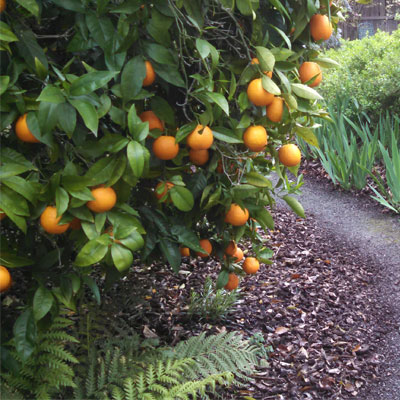Bay Area Fruit Tree Pruning & Care Services

Pruning fruit trees helps them stay healthy, produce more fruit, and look better. It does this by encouraging air circulation, preventing pests and diseases, and shaping and managing the size of the tree.
Our team of experienced fruit tree trimming and maintenance specialists will assess your trees and prune them in order to optimize their health, ascetics, and fruit production. Give us a call now for a free quote.
What Types of Fruit Trees Do We Prune?
We can prune pretty much any type of fruit tree. Some of the most common fruit trees that we work with are:
- Apricot
- Plum
- Apple
- Citrus fruits (lemon, lime, orange, grapefruit, etc.)
- Fig
- Peach
- Olive
- Avocado
- Nectarine
- Pomegranate
- Persimmon
- Loquat
- Pear
- Cherry
- Quince
When to Prune Fruit Trees in Northern California
In general the best time to prune fruit trees is late winter during the dormant season of the tree. That being said, there are unique benefits to pruning in other seasons too. Here’s some information about the pros and cons of pruning during each season.
Late Winter
Pruning in late winter is great for encouraging growth and fruit production on smaller trees. This is because the tree’s energy is stored in the roots during this time of year, so pruning does not remove too much energy from the tree. It is also a great time to see the structure of the tree and plan your pruning accordingly.
Spring
Your tree will be newly invigorated in spring and will have the energy to put into growing new shoots, foliage, and flowers, followed by fruit production later in the year. Early spring pruning is ideal for controlling the height of a large. Pruning to reduce the height allows for easier access to fruit and lessens the tree’s activity in growing. It is also a good time to see any dead branches that need to be removed.
Summer
Summer pruning can also be used to reduce the height of a large fruit tree. This works well for cherry trees. Removing foliage takes energy away from the tree, slowing its growth.
Fall
Fall pruning is generally not recommended. The tree’s growth has slowed by this time of year, so it will be harder for the pruning cuts to heal.
How to Prune a Fruit Tree
Prune fruit trees can be done using the following process:
Step 1
Start by inspecting the tree and identifying any dead, diseased or damaged branches. These should be pruned back to healthy wood with a slightly angled cut just above a bud.
Step 2
Remove any branches that are crossing over each other or growing towards the center of the tree. This will allow more light and air to reach the center of the tree, improving fruit production and reducing the risk of pests and diseases.
Step 3
Prune the tree to the desired shape and size. If the tree is too tall, remove the upper branches to bring it down to a more manageable height. If the tree is too wide, remove some of the lateral branches to reduce the spread.
Step 4
Cut away any water sprouts (rapidly growing vertical shoots) that emerge from the trunk or main branches of the tree. These are non-productive and can weaken the tree.
Step 5
Once the pruning process is done make sure to clean and sanitize your pruning tools to prevent the spread of disease.
It’s important to note that the timing of pruning can vary depending on the type of fruit tree and your location, so be sure to research the best time to prune for your specific situation.
How Much Does Fruit Tree Pruning Cost in the San Francisco Bay Area?
The cost of pruning a fruit tree in the San Francisco Bay Area ranges from $100-$1,400. The main factors that impact the price are the size of the tree, depth of the tree, and how many branches need to be trimmed.
Where Do You Provide Fruit Tree Care and Maintenance Services?
Our service area encompasses the entire Silicon Valley/South Bay Area and most of the Peninsula. This includes cities the following cities: Cupertino, Los Altos, Sunnyvale, Mountain View, San Jose, Saratoga, Los Gatos, Santa Clara, San Mateo, Palo Alto, Menlo Park, Redwood City, Campbell, Woodside, Atherton, Burlingame, Half Moon Bay, Pacifica, Milpitas, San Carlos, Belmont, Morgan Hill, Foster City, Portola Valley, and more.
